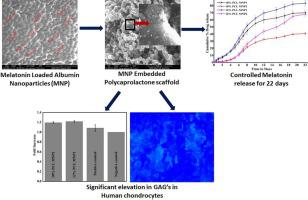当前位置:
X-MOL 学术
›
Process Biochem.
›
论文详情
Our official English website, www.x-mol.net, welcomes your
feedback! (Note: you will need to create a separate account there.)
Melatonin delivery from PCL scaffold enhances glycosaminoglycans deposition in human chondrocytes – Bioactive scaffold model for cartilage regeneration
Process Biochemistry ( IF 3.7 ) Pub Date : 2020-12-01 , DOI: 10.1016/j.procbio.2020.08.015 Manjunath Kamath S. , Subha Krishna Rao , Jaison D. , Sridhar K. , Kasthuri N. , Gopinath V. , Sivaperumal P. , Shantanu Patil S.
Process Biochemistry ( IF 3.7 ) Pub Date : 2020-12-01 , DOI: 10.1016/j.procbio.2020.08.015 Manjunath Kamath S. , Subha Krishna Rao , Jaison D. , Sridhar K. , Kasthuri N. , Gopinath V. , Sivaperumal P. , Shantanu Patil S.

|
Abstract The therapeutic potential of an engineered cartilage construct can be enhanced by sustained delivery of chondrogenic drug like melatonin from 3D porous scaffolds embedded with melatonin loaded bovine serum albumin nanoparticles (MNP). In this study, MNP was synthesized and loaded into polycaprolactone (PCL) scaffolds. 12 % (w/v) and 10 % (w/v) PCL scaffolds were fabricated with different concentrations of MNP. X- ray diffraction and Raman analysis of MNP and scaffolds revealed amorphization of melatonin which is highly desired in drug delivery applications. Additionally, Fourier Transform Infrared spectroscopic analysis confirmed the drug to be chemically inert to fabrication process. Field emission scanning electron microscopic analysis suggested highly interlinked porous scaffold (diameter 50 μm – 300 μm) and MNP diameters in the range of 110−200 nm. Importantly, UV spectrophotometric analysis showed that all groups of scaffolds showed sustained release for 21 days, wherein MNP concentration had an influence on release behaviour of melatonin from scaffolds. Drug release kinetics studied using mathematical models revealed, diffusion and dissolution mechanism of release. Furthermore, in vitro evaluation of MNP loaded scaffolds with Human chondrocytes for 21 days increased glycosaminoglycans deposition significantly. In brief, sustained release of melatonin from polycaprolactone scaffolds increased the therapeutic potential of the engineered construct.
中文翻译:

来自 PCL 支架的褪黑激素递送增强了人软骨细胞中的糖胺聚糖沉积——软骨再生的生物活性支架模型
摘要 通过从嵌入了负载褪黑激素的牛血清白蛋白纳米颗粒 (MNP) 的 3D 多孔支架中持续递送褪黑激素等软骨形成药物,可以增强工程软骨构建体的治疗潜力。在这项研究中,MNP 被合成并加载到聚己内酯 (PCL) 支架中。12% (w/v) 和 10% (w/v) PCL 支架是用不同浓度的 MNP 制造的。MNP 和支架的 X 射线衍射和拉曼分析揭示了褪黑激素的非晶化,这在药物递送应用中是非常需要的。此外,傅立叶变换红外光谱分析证实该药物对制造过程具有化学惰性。场发射扫描电子显微镜分析表明高度互连的多孔支架(直径 50 μm – 300 μm)和 MNP 直径在 110-200 nm 范围内。重要的是,紫外分光光度法分析表明,所有组支架均显示持续释放 21 天,其中 MNP 浓度对支架中褪黑激素的释放行为有影响。使用数学模型研究药物释放动力学、扩散和溶出释放机制。此外,用人软骨细胞对装载 MNP 的支架进行 21 天的体外评估,显着增加了糖胺聚糖的沉积。简而言之,褪黑激素从聚己内酯支架中的持续释放增加了工程结构的治疗潜力。紫外分光光度法分析表明,所有组支架均显示持续释放21天,其中MNP浓度对褪黑激素从支架中的释放行为有影响。使用数学模型研究药物释放动力学、扩散和溶出释放机制。此外,用人软骨细胞对装载 MNP 的支架进行 21 天的体外评估,显着增加了糖胺聚糖的沉积。简而言之,褪黑激素从聚己内酯支架中的持续释放增加了工程结构的治疗潜力。紫外分光光度法分析表明,所有组支架均显示持续释放21天,其中MNP浓度对褪黑激素从支架中的释放行为有影响。使用数学模型研究药物释放动力学、扩散和溶出释放机制。此外,用人软骨细胞对装载 MNP 的支架进行 21 天的体外评估,显着增加了糖胺聚糖的沉积。简而言之,褪黑激素从聚己内酯支架中的持续释放增加了工程结构的治疗潜力。此外,用人软骨细胞对装载 MNP 的支架进行 21 天的体外评估,显着增加了糖胺聚糖的沉积。简而言之,褪黑激素从聚己内酯支架中的持续释放增加了工程结构的治疗潜力。此外,用人软骨细胞对装载 MNP 的支架进行 21 天的体外评估,显着增加了糖胺聚糖的沉积。简而言之,褪黑激素从聚己内酯支架中的持续释放增加了工程结构的治疗潜力。
更新日期:2020-12-01
中文翻译:

来自 PCL 支架的褪黑激素递送增强了人软骨细胞中的糖胺聚糖沉积——软骨再生的生物活性支架模型
摘要 通过从嵌入了负载褪黑激素的牛血清白蛋白纳米颗粒 (MNP) 的 3D 多孔支架中持续递送褪黑激素等软骨形成药物,可以增强工程软骨构建体的治疗潜力。在这项研究中,MNP 被合成并加载到聚己内酯 (PCL) 支架中。12% (w/v) 和 10% (w/v) PCL 支架是用不同浓度的 MNP 制造的。MNP 和支架的 X 射线衍射和拉曼分析揭示了褪黑激素的非晶化,这在药物递送应用中是非常需要的。此外,傅立叶变换红外光谱分析证实该药物对制造过程具有化学惰性。场发射扫描电子显微镜分析表明高度互连的多孔支架(直径 50 μm – 300 μm)和 MNP 直径在 110-200 nm 范围内。重要的是,紫外分光光度法分析表明,所有组支架均显示持续释放 21 天,其中 MNP 浓度对支架中褪黑激素的释放行为有影响。使用数学模型研究药物释放动力学、扩散和溶出释放机制。此外,用人软骨细胞对装载 MNP 的支架进行 21 天的体外评估,显着增加了糖胺聚糖的沉积。简而言之,褪黑激素从聚己内酯支架中的持续释放增加了工程结构的治疗潜力。紫外分光光度法分析表明,所有组支架均显示持续释放21天,其中MNP浓度对褪黑激素从支架中的释放行为有影响。使用数学模型研究药物释放动力学、扩散和溶出释放机制。此外,用人软骨细胞对装载 MNP 的支架进行 21 天的体外评估,显着增加了糖胺聚糖的沉积。简而言之,褪黑激素从聚己内酯支架中的持续释放增加了工程结构的治疗潜力。紫外分光光度法分析表明,所有组支架均显示持续释放21天,其中MNP浓度对褪黑激素从支架中的释放行为有影响。使用数学模型研究药物释放动力学、扩散和溶出释放机制。此外,用人软骨细胞对装载 MNP 的支架进行 21 天的体外评估,显着增加了糖胺聚糖的沉积。简而言之,褪黑激素从聚己内酯支架中的持续释放增加了工程结构的治疗潜力。此外,用人软骨细胞对装载 MNP 的支架进行 21 天的体外评估,显着增加了糖胺聚糖的沉积。简而言之,褪黑激素从聚己内酯支架中的持续释放增加了工程结构的治疗潜力。此外,用人软骨细胞对装载 MNP 的支架进行 21 天的体外评估,显着增加了糖胺聚糖的沉积。简而言之,褪黑激素从聚己内酯支架中的持续释放增加了工程结构的治疗潜力。











































 京公网安备 11010802027423号
京公网安备 11010802027423号